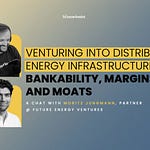Welcome to the 89th edition of Deep Tech Catalyst, the channel from The Scenarionist where science meets venture!
This episode goes deep into one of the most underexplored—but critically important—realities of scaling scientific innovation: how to break into the construction industry with a product that actually gets used on-site.
To help us decode this, we’re joined by Burak Gursel, Acquisition & Integration Manager at Simpson Strong-Tie!
Together, we explore what it takes to turn a functional prototype—whether a novel material, sensor, or engineered product—into something that can win the trust of engineers, pass code approvals, and survive the brutal practicality of a construction site.
In this edition, we unpack:
Why engineers—not innovation teams—are the real gatekeepers of adoption
How to structure early field pilots without giving your product away
What founders must get right before talking to procurement
Why manufacturing should be outsourced early—and how to talk about it credibly
How strategic investors think differently than VCs—and what they look for beyond the pitch
Whether you’re a scientist-founder bringing a new construction tech to market, an investor evaluating physical product startups, or a deep tech builder navigating complex adoption cycles—this episode is a field guide to entering the built world.
Let’s get into it. 🏗️
✨ For more, see Membership | Deep Tech Briefing | Insights | VC Guides
BEYOND THE CONVERSATION — STRATEGIC INSIGHTS FROM THE EPISODE
From Deep Tech Prototype to Construction Solutions
Many Deep Tech founders entering the construction space believe that proving their technology works in the lab is the hardest part. But in truth, that’s only the beginning. The real challenge begins once the prototype is built and functioning—when it’s time to bring the product into the hands of those who might actually use it on a job site.
At this stage, a few realities come into focus. First, construction is not a fast-moving industry. Adoption cycles are long, and even highly promising technologies face skepticism. The product must not only work—it must fit into how things are already done. It must be accepted, specified, and ultimately installed in the field. That path isn’t linear, and it certainly isn’t short.
The First Real Milestone Is Not the Sale. It’s the Specification.
In construction, products are not casually chosen at the last minute. They must be written into the project documents—into the blueprints and structural plans that guide everything else. That’s why founders need to work closely with engineers, particularly structural engineers who act as the "gatekeepers" for what materials and products actually get used.
Without specification, the rest of the process stalls. A contractor may like the idea. A procurement team might be intrigued. But if the engineer hasn’t signed off, the product stays on the shelf.
This step often requires technical validation: code approvals, supporting documentation, and performance data that the engineering community can rely on. It’s not about marketing—it’s about earning trust through clarity and compliance.
Don’t Wait for Scale—Start in the Field
Once the specification is possible, the next hurdle is field validation. Even if engineers approve the product, contractors won’t use it unless it makes sense on-site. That means startups must be prepared to move from boardroom meetings to job site walk-throughs. What matters most is how the product performs in real-world conditions—with dust, noise, unpredictable delays, and the pressure of deadlines.
At this stage, pilot projects become crucial. These are not formal rollouts—they are opportunities to observe, support, and learn. Often, these pilots require hand-holding.
Founders (or someone senior) should be present. They should answer questions, adapt on the fly, and collect feedback directly from the teams installing and using the product.
These early pilots are also when trust is built. If something goes wrong—and it usually will—it’s the responsiveness and commitment of the startup that makes the difference. The construction team needs to see that you're not just testing a theory. You’re invested in making it work.
Managing Early Expectations
Startups often underestimate how slow the process can be. In construction, no decision happens overnight. Even if the product proves its worth in a pilot, it may take a full year or more before the next opportunity arises to deploy it at scale.
That’s why the early stage isn’t about rapid growth. It’s about deliberate positioning: getting the right engineers to know the product exists, securing early specification wins, and delivering results in a few well-chosen pilot projects. Success in these first steps lays the groundwork for everything that follows.
This phase is also when many startups get discouraged. They expect traction to come faster, or they misinterpret early enthusiasm as a buying signal. But in construction, traction is rarely loud. It builds slowly—through credibility, consistency, and repetition.
Navigating the Stakeholder Maze
Bringing a new product into the construction world doesn’t just require a good solution. It requires navigating a complex network of stakeholders, each with different priorities, expectations, and levels of influence. Understanding how to approach each of them—on their own terms—is what separates startups that get stuck in endless conversations from those that get real adoption.
The Engineer Is the Gatekeeper
Before a single screw is turned or a beam is poured, construction begins on paper. It starts with specifications—technical documents written by engineers that determine exactly what materials and products will be used. If a new technology isn’t in that documentation, it’s effectively invisible. That’s why earning the trust of the engineering community is not optional—it’s foundational.
Engineers are responsible for ensuring that every component of a building performs as required under load, over time, and under variable conditions. Their decisions are deeply tied to safety, liability, and compliance.
So if a product is not proven, or not recognized in codes or standards, it simply won’t be used—regardless of how innovative it might be.
To move forward, founders must learn to speak the engineer’s language.
That doesn’t mean just offering lab results or pitch decks—it means presenting the product within the frameworks that engineers already work in. Show how it fits into design workflows, how it aligns with existing codes, and what evidence supports its reliability.
Engineers are cautious by design. They are trained to look for failure modes, to protect safety margins, to question assumptions. Startups that understand and respect that mindset will have a much easier time building relationships that translate into actual projects.
Getting specified is a milestone. Getting installed is a bigger one. And getting called back for the next job—that’s when you know the product is starting to earn its place in the construction ecosystem.
Procurement: Reliability Over Novelty
Once a product is specified, the next gate is often the procurement team. Their job is to ensure that materials can be delivered on time, at the right price, and with minimal disruption. They aren’t looking for innovation—they’re looking for consistency.
Startups that approach procurement with a technology-first pitch usually lose the room. What matters here is supply chain clarity: who manufactures the product, what the lead times are, how pricing compares to alternatives, and what happens if there’s a delay or defect.
The best approach is to come with answers already prepared. Show that you understand how procurement operates, and that you’re not just pitching a great product—you’re offering a solution that fits into existing systems.
Field Teams: The Hidden Decision-Makers
There’s another group whose influence is often underestimated: the people who actually install the product. In many cases, these field teams act as the final gatekeepers. If the solution is difficult to handle, unclear to use, or simply slows down the job, they’ll reject it—even if it’s been specified and purchased.
That’s why engaging with foremen, installers, and site managers is essential. And these conversations are not about abstract value—they’re about job-site realities.
Can this be installed with two people instead of four?
Does it reduce time spent on rework?
Is it intuitive, or does it require special training?
In these discussions, practicality beats innovation every time. It’s not about how advanced the product is—it’s about whether it makes their day easier. Founders who dismiss this group or assume the product will “speak for itself” often hit a wall during implementation.
Tailor the Message: Focus on ROI, Not Tech Jargon
Each stakeholder group needs a different message. Founders should resist the urge to pitch everyone the same way. A CTO at a large construction firm may care about strategic alignment. A procurement manager cares about lead time. An installer cares about ease of use.
Before reaching out, take the time to understand the company. Learn what they build, who their clients are, and what challenges they’re facing right now. Then lead with specifics—not with general questions like “What are your pain points?”.
These professionals are overloaded and don’t have time to educate you about their problems. They expect that if you’re calling, you’ve already identified one of them—and have a credible solution in hand.
What they want is a clear, measurable outcome: lower cost, faster execution, fewer reworks, higher quality. That’s what gets attention. That’s what drives engagement. And that’s what opens the door to real adoption.
Exits in Advanced Materials Startups
3 Case Studies on How Exits Were Strategically Engineered Behind the Scenes.
Designing Effective Pilot Programs
In the early stages of market entry, pilot programs play a crucial role. They are not just a chance to demonstrate functionality—they are the first real test of commercial readiness.
A well-designed pilot can unlock long-term adoption, while a poorly structured one can derail credibility before the product even gets started.
But to work, pilots need more than just enthusiasm. They require structure, protection, and above all, clarity about what each side expects to gain.
Start with IP Protection in Place
Before moving ahead with any pilot, founders should first make sure their intellectual property is protected. The very first step is straightforward: put a non-disclosure agreement (NDA) in place to prevent leakage of the startup’s developments.
This isn’t just a formality. The core technical assets—the designs, processes, or materials a startup has created—are the foundation of its value. Legal teams can usually guide this process, but it’s up to founders to make sure safeguards are there from the start.
De-Risk the Commitment for the Customer
From the customer’s side, trying something new is inherently risky. It can cost time, require internal coordination, and expose them to the unknown. That’s why founders need to lower the barrier to entry.
One effective approach is to structure pilots as month-to-month engagements, with low upfront costs and clearly defined scopes. This gives the customer breathing room to try the product without feeling locked into a long-term commitment. It also sets expectations: this is a test, not a full-scale rollout.
That said, even in early-stage pilots, it’s important to avoid working for free. Offering something for nothing tends to signal that it has little value. Worse, it often leads to lower engagement from the customer. A small payment—symbolic or discounted—creates accountability and signals that both sides are serious.
Pilot ≠ Proof of Concept
There is a subtle but important distinction between a proof of concept and a pilot project. Proof of concept is where you validate that the product works in a real-world environment, perhaps on a limited scope, even offering it at no cost. This is the startup’s chance to collect feedback, debug, and refine the application.
But once that stage is complete, the startup should move toward paid pilots—structured agreements with clear deliverables, customer involvement, and value exchange. Continuing to give away products after the proof phase weakens the startup’s position and can delay the path to commercial traction.
Show Up—Literally
Pilots are not hands-off. In construction, things change by the hour, not by the quarter. If something goes wrong on-site and no one from the startup is there to see it, the pilot risks failure—not because the product didn’t work, but because no one was present to adapt.
Again, that’s why physical presence on the job site is not optional.
Whether it’s the founder, a technical lead, or a field engineer, someone from the startup needs to be there to support the installation, answer questions, and collect real-time feedback.
This hands-on support does more than solve problems—it builds trust. It shows the customer that the startup isn’t just selling a product; it’s offering a partnership.
Paid Pilots as a Signal to Investors
Finally, it’s worth noting that even modest commercial engagement—especially in the form of a paid pilot—is a powerful signal to investors. It shows that the product isn’t just interesting; it’s being used.
It demonstrates real-world demand, willingness to pay, and an early understanding of pricing dynamics.
The goal of the pilot phase isn’t just to test the technology—it’s to prove that the company can deliver, support, and monetize its innovation in a highly practical industry. When structured well, a pilot isn’t just a stepping stone. It’s a foundation for scale.
Is it Possible to Scale Production Without Owning a Factory?
For some Deep Tech startups, especially those emerging from academic or lab environments, the question of manufacturing can feel like a distant concern—something to be solved later, once demand materializes. But in construction, that’s a luxury you don’t have.
The moment you begin engaging serious customers, the question becomes immediate and concrete:
Who’s going to make this?
And how soon can I get it on-site?
Having a working prototype is not enough. The ability to deliver a real product, at a reliable price, within a predictable timeline, is part of what gets you taken seriously. If you don’t have a manufacturing plan in place, you may not even make it to the next meeting.
The Field Will Ask Tough Questions
Professionals in construction—especially those in charge of procurement or project execution—have learned the hard way what happens when suppliers can’t deliver.
Even well-established vendors occasionally miss shipments, run out of stock, or mismanage production. So when a startup enters the picture, the first instinct is caution.
That’s why field teams, project managers, and buyers will immediately press you on details:
Who is producing this?
Where is it being made?
What’s the lead time?
What’s the unit price?
Can you guarantee availability?
You don’t need to have a warehouse full of inventory, but you do need to show that you’ve thought this through—and that you have a manufacturing partner lined up, even if you're still in low-volume mode. Saying “we’ll figure that out once we get the order” doesn’t fly.
Outsourcing Production Is an Option
Trying to build your own manufacturing capabilities too early is not only capital-intensive—it’s usually unnecessary. In most cases, partnering with an experienced manufacturer is not a compromise; it’s a smart way to de-risk operations and focus your limited resources where they matter most: on product development, customer engagement, and iteration.
Startups often fall into the trap of believing that owning the production process gives them more control. But in practice, unless you already have deep expertise and infrastructure, it creates more distractions than advantages. Manufacturing at scale is a discipline of its own—one that can drain time, capital, and energy away from your core business.
An effective option is to find a reliable partner who can produce at small volumes initially, with the flexibility to scale up as demand grows. This gives you the ability to quote lead times, present unit costs, and support pilot deployments—without locking up capital in equipment or facilities.
Know Your Costs—Even Before Scaling
Another mistake to avoid is waiting too long to define your cost structure. Even at early stages, when volumes are low and unit economics aren’t fully optimized, it’s critical to understand your base costs.
It’s important because the moment you start talking to customers, they’ll ask:
What does it cost per unit?
How much will it be at 100 pieces? At 1,000?
Can you hold that price for 6 months?
You don’t need to have perfect answers, but you need to have credible ones.
This means working with your manufacturing partner to develop a realistic cost model, even if it’s based on estimates. Not having a pricing baseline signals that the business isn’t ready—and in construction, that kind of uncertainty kills momentum.
Capital Efficiency
At this stage, every dollar raised matters. Founders need to be ruthless about how capital is allocated. Unless manufacturing is your core innovation (e.g. novel fabrication techniques or IP-protected production processes), then it should be outsourced wherever possible.
Investors want to see startups preserving capital for R&D, hiring key people, running pilots, and building sales traction. Spending significant funds on machines, leases, or custom equipment—before real demand exists—is rarely justifiable.
As the company matures, there may be a point where bringing manufacturing in-house makes strategic sense. But in the early stages, staying asset-light is what gives you flexibility—and optionality.
The Strategic Investor Lens in Construction
When approaching strategic investors—especially those embedded in the construction ecosystem—many founders bring the wrong playbook.
Strategic backers aren’t just writing checks. They are evaluating whether your company—and your technology—can create value inside their operation. That means the expectations, the timelines, and even the relationship dynamics are fundamentally different.
Understanding these elements is critical.
Know Who You’re Talking To
The first mistake many founders make is simple but costly: they don’t take the time to research the investor’s business before the first conversation. They reach out asking for money, introductions, or partnership opportunities—without knowing what the company actually does.
This might be tolerated in a general VC setting.
But for a strategic investor, it’s a red flag. These organizations expect you to come prepared—with a clear understanding of their product lines, customers, strategic goals, and where your innovation fits into that puzzle.
If you're asking them to invest, you should already know how your solution strengthens their position—whether by expanding their product offering, reducing costs, unlocking new markets, or giving them a technical edge.
Show the Business Fit, Not Just the Tech
A strong technology alone isn’t enough. Strategic investors want to understand how it becomes a business advantage for them. That means presenting more than a good idea—you need to walk in with a real use case, backed by initial traction or market signals.
Are you solving a specific pain point they already face?
Can your solution help them enter a segment they don’t currently serve?
Will it differentiate them in a crowded marketplace?
If the conversation stays at the level of features or performance specs, you’ll lose momentum. Strategic investors are thinking about how this integrates with supply chains, go-to-market strategies, and long-term differentiation. Founders who can bridge the technical with the commercial are the ones who make it to the next meeting.
Patience Is Not Optional
Compared to institutional VCs, strategic investors move more slowly. Decision-making involves multiple departments—business units, legal, R&D, and finance—and consensus takes time. Even highly interested parties may take weeks or months to formalize a response.
That’s why founders must manage expectations. If your fundraising plan relies on a quick yes from a strategic, you’re setting yourself up for frustration. These are not transactions—they are partnerships in the making. And partnerships, by nature, require trust, alignment, and time.
Prepare a Relationship, Not Just a Deal
To be effective with a strategic investor, think beyond the transaction. Don’t ask only, “Will you invest?” Instead, be ready to propose a working model. Here’s how we could collaborate. Here’s what we need from you. Here’s what you’d gain.
This clarity goes a long way. It shifts the tone from a pitch to a partnership. And in most cases, it’s this shift that opens the door.
30 Venture Lessons to Build and Back Great Deep Tech Companies
A curated selection of the most valuable insights I’ve gained from 50+ global Deep Tech VCs, CVCs, and experts on building and supporting early-stage Deep Tech startups.













